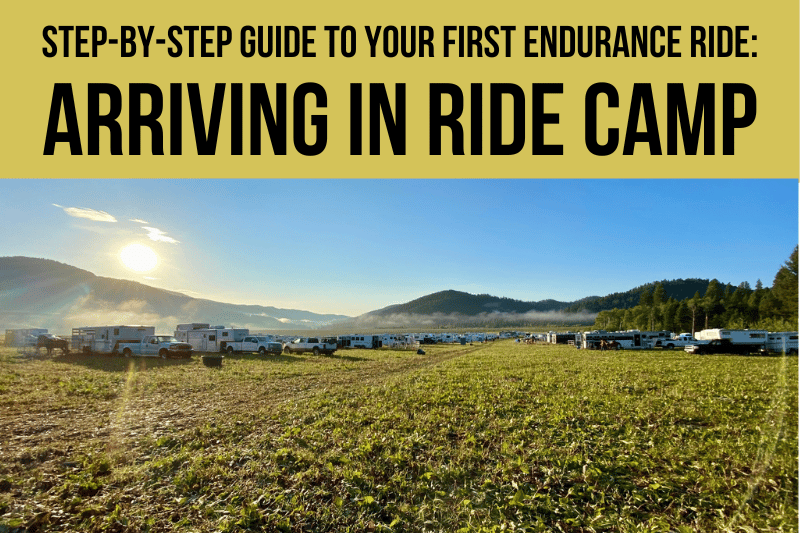Dr. Ribley is an extremely experienced endurance vet and rider. Not only does her AERC record span well over 20,000 miles, it also reflects her love of traveling with her horses. Competing in different regions means implementing good hauling practices and being prepared for all types of climate and terrain.
Here are my notes from her talk:
Five Reasons to Ride Out-of-Region
Dr. Ribley started by sharing some enticing reasons to explore endurance rides in other regions:
- Meet interesting people
- Improve your riding skills
- See the country (Dr. Ribley recommends going early and staying late!)
- Spend time with your horse
- Challenge yourself
Tips for Traveling with Your Horse
Dr. Ribley provided excellent advice that can reduce stress for both horses and humans on cross-country treks with the trailer:
- Plan your route ahead of time. Schedule to avoid high traffic areas during rush hour, and know where you’re going to stop overnight.
- Fairgrounds often have shower facilities, in addition to generous turnout space for the horses. Rodeo grounds and horse motels provide additional options.
- Riding in the trailer costs your horse about as much energy as walking. Stop every 3 hours to let him rest inside the trailer. Extra unloading and reloading in unfamiliar locations increases injury potential.
- Blowing hay particles can get into horses’ eyes and respiratory systems. Consider feeding hay only when the trailer is stopped, or providing wetted hay while driving.
- Tie horses in the trailer as needed for safety, but let them lower their heads below chest level as much as possible. This allows them to clear their tracheas of particulate and bacteria that would otherwise accumulate in the lungs.
- Remember your paperwork. (Coggins, health certificates, brand inspections, etc.)
- As a rule of thumb, allow one day of rest for each day of travel prior to an endurance event. One exception: Horses are slow to adapt to high altitude, so if you’re making a dramatic upward change in elevation, plan to get there either the day before the ride or weeks early.
Tips for Riding in Diverse Terrain
Once you get to your destination and give your horse some rest, it’s time to ride! Dr. Ribley offered thoughts to bear in mind when riding in different types of terrain:
- Rocky terrain poses risk of sole bruising and collateral ligament strains, as well as trip-and-fall injuries. The easiest and most obvious preventative measure is to slow down. Pads or boots help protect soles. Pour-in pads may be preferable to nail-in pads, which loosen the shoe nails as they flex with each step.
- Sandy terrain fatigues muscles and can lead to strained suspensory ligaments and flexor tendons. Conditioning for sand before competing in it is extremely important.
- Hard-packed terrain is concussive to the horse, particularly his hooves. Pedal osteitis (inflammation of the coffin bone) causes soreness that may require treatment with rest and anti-inflammatories. Laminitis, or “road founder,” can occur as excessive concussion reduces blood flow to the laminae, which tear, resulting in downward rotation of the coffin bone. Due to long-term risk of degenerative joint disease, it’s wise to minimize conditioning on hard-packed terrain. At rides, look for softer footing off to the side and slow down to reduce concussion.
- Flat terrain looks easy, but looks are deceiving. Flat terrain requires use of the same muscle groups over long periods, leading to fatigue. Riders can help by varying the horse’s speed and gait.
Tips for Riding in Diverse Climate Conditions
As both a vet and a rider, Dr. Ribley is well acquainted with the impact of climate on horses’ ability to perform. She shared some excellent advice for keeping our equine partners safe in all conditions:
- Cold and dry weather makes for lower risk of dehydration and hyperthermia (overheating). Endurance vets see fewer metabolic pulls at cool, dry rides – but more lameness pulls, presumably because the horses are moving faster. Riders should take care to avoid overtaxing their horses mechanically. Also, blankets should be on hand prevent horses from getting chilled when they stop moving.
- Cold and wet weather is often accompanied by challenging footing, making injury more likely. In chilly conditions, it’s best to let horses sweat and dry on their own instead of sponging, which can cool them too fast. (This reminds me of the time a vet actually thanked me for bringing a dry horse to show for BC on a crisp day. He said he’d seen too many already that were hosed off and shivering.)
- Hot and dry weather makes evaporative cooling quite effective. In these conditions, a horse may be cooled using water that is at the ambient temperature.
- Hot and humid weather is metabolically challenging for horses. Evaporative cooling is less effective and hyperthermia risk goes up. In humid conditions, use water than is cooler than the air to bring down a horse’s temperature.
To cool a hot horse, Dr. Ribley advised riders to remove the horse’s tack. Get the horse into the shade, ideally on a relatively cool surface (grass instead of blacktop). If possible, assist evaporative cooling with water and fans. Cooling may be enhanced by adding rubbing alcohol to water at a rate of ½ pint of alcohol per gallon of water. Check for abrasions first, since the alcohol will sting.
Finally, Dr. Ribley mentioned a study of Olympic 3-day eventers that showed no ill effects of wetting horses all over with ice water.
Interesting stuff!





Good notes.
Thanks
You’re very welcome — and it’s good to “see” you! 🙂